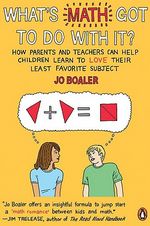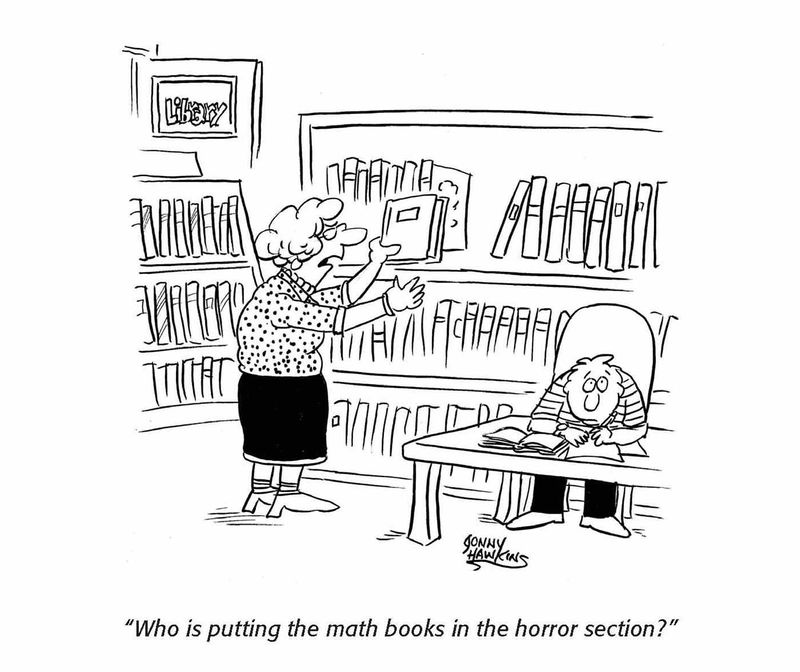References
From Classes
Revision as of 14:18, 3 May 2022 by HelmutKnaust (Talk | contribs)
School Mathematics and Beyond
- Jo Boaler, What's Math Got to Do with It? How Parents and Teachers Can Help Children Learn Their Least Favorite Subject. Penguin 2008.
- "Jo Boaler shows that math is understandable, and that it can be fun to get your head around it - but that it's often taught in ways that make it dry and deadly. She points to the beauty and joy of mathematics, and ways that math classrooms can become centers of lively mathematical thinking. American children deserve a richer mathematical diet than we've given them, and Boaler shows how and why." (Alan H. Schoenfeld)
- Jo Boaler, Experiencing School Mathematics: Traditional and Reform Approaches to Teaching and Their Impact on Student Learning. Routledge 2002.
- "Through her comprehensive, penetrating study of the mathematics departments in two English schools, Jo Boaler shows how mathematics teaching and learning are shaped by teachers and by the settings in which they work." (Jeremy Kilpatrick)
- Edward B. Burger & Robert Tubbs, Making Transcendence Transparent: An intuitive approach to classical transcendental number theory. Springer-Verlag, 2004.
- An introduction to transcendental number theory, at the advanced undergraduate/beginning graduate level.
- Heinz-Dieter Ebbinghaus et al., Numbers. Springer-Verlag, 1996.
- Real numbers, complex numbers, quaternions - what's next? The first part of the book is quite accessible, but the going gets tougher in the later chapters.
- Fernando Q. Gouvêa: Was Cantor Surprised? American Mathematical Monthly, March 2011.
- About the correspondence between Cantor and Dedekind.
- Liang-shin Hahn, Complex Numbers and Geometry. Mathematical Association of America, 1994.
- "Provides a self-contained introduction to complex numbers and college geometry written in an informal style with an emphasis on the motivation behind the ideas ... The author engages the reader with a casual style, motivational questions, interesting problems and historical notes." (Mathematical Reviews)
- Michael Henle, Which Numbers are Real? Mathematical Association of America, 2012.
- "Everyone knows the real numbers, those fundamental quantities that make possible all of mathematics from high school algebra and Euclidean geometry through the Calculus and beyond; and also serve as the basis for measurement in science, industry, and ordinary life. This book surveys alternative real number systems: systems that generalize and extend the real numbers yet stay close to these properties that make the reals central to mathematics."
- Ron Irving, Beyond the Quadratic Formula. Mathematical Association of America, 2013.
- "The quadratic formula for the solution of quadratic equations was discovered independently by scholars in many ancient cultures and is familiar to everyone. Less well known are formulas for solutions of cubic and quartic equations whose discovery was the high point of 16th century mathematics. Their study forms the heart of this book, as part of the broader theme that a polynomial's coefficients can be used to obtain detailed information on its roots."
- Felix Klein, Elementary Mathematics from an Advanced Standpoint: Arithmetic, Algebra, Analysis. Dover 2004.
- Felix Klein, Elementary Mathematics from an Advanced Standpoint: Geometry. Dover 2004.
- "Written in 1932, Klein's Elementarmathematik lectures was intended as a survey of mathematics for those who already knew most of the technical detail, especially future teachers, but who perhaps lacked a good understanding of mathematics as a whole. The lack of a broad perspective is probably at least as big a problem today as it was then, so Klein's text is still valuable. Klein also frequently discusses historical and pedagogical aspects, and the tone is quite informal throughout." (Viktor Blasjo)
- Edmund Landau, Grundlagen der Analysis. (Also available in English as Foundations of Analysis.) AMS Chelsea Publishing.
- A classic written in the 1920s. An axiomatic construction of numbers and concise derivation of their fundamental properties, from the natural numbers to the complex numbers.
- Liping Ma, Knowing and Teaching Elementary Mathematics: Teachers' Understanding of Fundamental Mathematics in China and the United States. Lawrence Erlbaum Associates, 1999.
- Robert P. Moses and Charles E. Cobb, Jr., Radical Equations: Civil Rights from Mississippi to the Algebra Project. Beacon, 2002.
- Moses was already a venerable civil rights campaigner when he embarked on what became an illustrious career in education and mathematics. He has now returned to Mississippi to teach math to descendants of the sharecroppers he helped mobilize 40 years before. With journalist and fellow activist Cobb, he tells his personal story and shares his vision of universal math literacy among poor and minority children. He founded the Algebra Project. (Book News)
- Tristan Needham, Visual Complex Analysis. Oxford University Press, 1999.
- A unique book developing complex analysis from a geometric angle.
- Ivan Niven, A simple proof that π is irrational. Bull AMS 53 (1947), 509.
- Only about half a page...
- Ivan Niven, Numbers: Rational and Irrational. Mathematical Association of America, 1961.
- "A superb development that starts with the natural numbers and carries the reader through the rationals and their decimal representations to algebraic numbers and then to the real numbers. Along the way, you will see characterizations of the rationals and of certain special (Liouville) transcendental numbers."
- Claude M. Steele, Whistling Vivaldi: How Stereotypes Affect Us and What We Can Do. W. W. Norton & Company, reprint ed. 2011.
- "This is a surprising book. Within its pages, the highly thought-of social psychologist shows us how, even in the absence of explicit racism, negative stereotypes can continue to pervade American life, and have far-reaching influences on our behavior." (Stephanie de Pue)
- Otto Toeplitz, The Calculus. A Genetic Approach. The University of Chicago Press, 2007.
- Hung-Hsi Wu, The Mis-Education of Mathematics Teachers. Notices of the AMS, Volume 58(3), 2011.
- Hung-Hsi Wu, The Mathematics K-12 Teachers Need to Know.
- Hung-Hsi Wu, Phoenix Rising. Bringing the Common Core State Mathematics Standards to Life, American Educator, Fall 2011.
Some Math (and Science) History books
- Amir D. Aczel, The Mystery of the Aleph: Mathematics, the Kabbalah, and the Human Mind". Basic Books, 2000.
- "Aczel's compact and fascinating work of mathematical popularization uses the life and work of the German mathematician Georg Cantor (1845-1918) to describe the history of infinity of human thought about boundlessly large numbers, sequences and sets."
- Jerome D. Bernal, Science in History (4 vol.). 1954.
- "J. D. Bernal's monumental work Science in History is the first full-scale attempt to analyze the relationship between science and society throughout history, from the perfection of the first flint hand ax to the construction of the hydrogen bomb. This remarkable study illustrates the impetus given to and the limitations placed upon discovery and invention by pastoral, agricultural, feudal, capitalist, and socialist systems, and conversely the ways in which science has altered economic, social, and political beliefs and practices."
- Carl B. Boyer, The History of the Calculus and Its Conceptual Development. Dover, 1959.
- Martin Davis, The Universal Computer: The Road from Leibniz to Turing. W. W. Norton, 2000.
- Via Frege, Cantor, Gödel...
- Jared Diamond, Guns, Germs, and Steel: The Fates of Human Societies. W. W. Norton, 2005.
- William Dunham, Euler: The Master of Us All. MAA, 1999.
- Dirk Struik, A Concise History of Mathematics. Dover, 1967.


